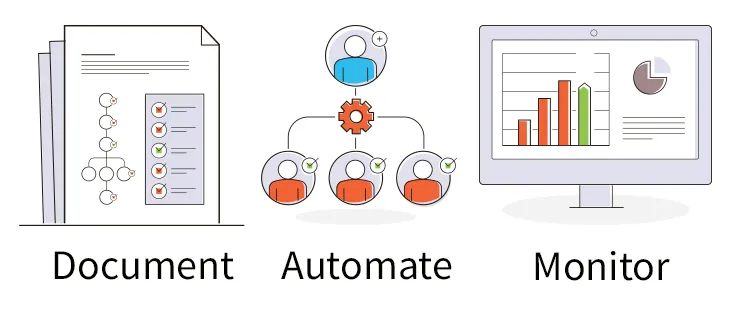Boost your business process visibility
Table of contents

Why Visibility Matters
If you ponder technological advances over the last 50 years, you will see how much of the benefit is really about increased visibility.
- Improved resolution in medical imaging allows earlier intervention into disease processes.
- Manufacturing processes benefit from real-time visibility into product quality and the proper operation of shop-floor machinery.
- Modern home security systems send alerts and video images to your mobile phone to give you real-time information about fires, break-ins, or any other mischief occurring on your property.
It's surprising that so many businesses still operate with insufficient business process visibility when today's workflow automation tools can provide greater process transparency that smoothes information flow and speeds up transactions. Process visibility accelerates decision-making and improves operational responsiveness.
Operational responsiveness requires decision-makers to have the tools and information needed for the earliest possible intervention into unexpected upturns or downturns. It's about driving ever-improving efficiency, plugging profitability holes, and reducing risk—and it's essential to retain a competitive advantage in today's marketplace.
How to Improve Business Process Visibility
Businesses can take an incremental approach to improve process visibility. There are three steps along that path:

Document
Many companies delegate process responsibility. They let processes evolve without formal review and approval. Ad hoc changes are made along the way to suit the needs of individual employees. These businesses can obtain essential visibility into their processes by documenting, in words or diagrams, their current operations, and looking for opportunities to improve them. The next logical step is to decide on key performance indicators (KPIs) to monitor the health and speed of each process. KPIs provide a strong foundation for building reports and dashboards that give additional visibility to ongoing process performance.
Automate
For too long, many managers have assumed that every employee is tracking their responsibilities. Daily work may still be managed with endless email reminders, personal task lists (either on paper or on-screen), spreadsheets, project plans, and centrally located whiteboards. When progress is lagging or problems arise, management goes on the hunt for answers to the question, "What went wrong?" Employees scramble to answer that question and avoid blame. Managers have difficulty discerning the truth and can't act quickly enough in crises.
Automated workflow rules can eliminate many ad hoc decisions and external "lookups." Handoffs no longer fall through the cracks in overflowing inboxes — no more errors due to manual offline calculations. Alerts are triggered and routed automatically according to business rules. Individual task lists are replaced by work queues maintained within the process automation software.
Automation makes it easier to set user expectations: they know what their role in the workflow is. They can be held accountable to specific service levels. No one can hide from responsibility or shortcut steps because the process automation software is tracking who performed each step in the process and when it was completed.
Monitor
Every manager needs visibility into operations, and they need it as close to real-time as possible. To avert catastrophe, they need to intervene as soon as they see the needle moving into the danger zone. Traditionally, visibility was provided in compiled spreadsheets, or daily/weekly/monthly reports that were circulated to managers on a need-to-know basis - and operational responsiveness was sluggish. With today's process automation tools, managers can log in at any time to obtain real-time information on business process health and intervene before situations become critical.
Viewing and Diagnosing Workflow Problems
Workflow automation software provides managers with well-designed real-time dashboards. They can easily find bottlenecks and address them by retraining staff, changing staff responsibilities, or fine-tuning business rules. If steps are being duplicated or reworked due to errors, the workflows can be changed quickly. The root cause of the errors can be traced easily within the system. If transaction time is too slow, there may be unnecessary manual work that can be automated with additional business rules.
Managers can view individual work queues directly to see which tasks require additional staffing. They can then take steps to retrain, coach, and support employees who may be struggling.
Seeing and Responding to Business Trends
Very few businesses operate at a steady state. There is an ebb and flow of transaction volumes due to business seasonality, the introduction of new products/services, penetration into new market sectors, competitive threats, changes in customer buying habits, or changes in the economic and geopolitical climate. Real-time dashboards provide managers with visibility into these trends so that they can intervene as quickly as possible. Historical data helps them understand any cyclical changes they need to make.
- When request volumes change , they can move and refocus staff on other activities and responsibilities.
- If process performance trends are apparent, managers can address training and boost employee engagement. They have accurate information that can be used in employee performance assessments. They also gain the necessary insights to design effective employee incentive strategies.
- With complete access to historical KPI performance, they can review what worked and what didn't the last time they faced a similar situation. They can plan more effectively for interim staffing needs during crunch periods or after a new product launch.
Don't Remain in the Dark!
Shine the light on your business processes and put your business or department on the right track. Improve operational responsiveness by boosting your process visibility with workflow automation.
- If you are struggling to document your processes, Nutrient Workflow provides a drag and drop workflow design that can help you understand and address your current process problems.
- If you are ready to automate your processes, we make it easy to implement workflow rules based on values, hierarchy, status, and other business conditions.
- If you need a more effective way to monitor your processes, we provide a complete audit trail on automated processes and give you views into employee performance against your desired SLAs.




